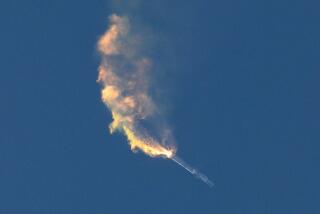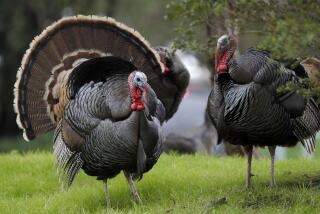Pre-Launch Mission: Get the Vulture Count Down
- Share via
CAPE CANAVERAL, Fla. — Stacy Sims, chief of NASA’s roadkill posse, was cruising the mist-shrouded highways that surround the space shuttle launch site when he spotted the mashed remains of a raccoon.
A flock of big, black vultures watched from nearby power lines, like hungry diners waiting for their favorite restaurant to open.
“Oh, this is a lovely job,” said Sims as he scooped up the dead animal with a shovel and threw it into the back of his truck, depriving the birds of their meal.
For decades, the vultures of Cape Canaveral have enjoyed a banquet served up daily by the thousands of commuters at the Kennedy Space Center. Workers used to move roadkill to the grassy roadsides so the vultures could eat in peace.
All that ended after the space shuttle Discovery hit a vulture as it lifted off from Pad 39B last year. In videos, the bird could be seen bouncing off the top of the external fuel tank several hundred feet above the ground. Two other vultures were immolated during the launch.
Although the birds missed the orbiter containing the crew, the event alarmed NASA managers, who, in 2003, saw a 1.7-pound piece of foam insulation from the shuttle’s external fuel tank strike Columbia, eventually causing its destruction and the deaths of all seven crew members.
“We talk about a quarter-pound piece of foam being catastrophic to the vehicle -- these are 4- to 6-pound birds,” flight director John Shannon said Thursday while discussing preparations for Saturday’s scheduled launch. “We laugh about it, but it is a serious risk.”
NASA will use radar to track the birds before liftoff. If too many vultures are deemed too close to the shuttle, the data “will allow us to make a real-time call about holding the launch to give them time to fly out,” said shuttle launch director Mike Leinbach.
Since the Columbia disaster, NASA has spent billions trying to ensure nothing hits the shuttle during launches.
Sims is doing his part with a shovel and a pair of gloves.
It’s a job with a lot of variety -- raccoons, possums, armadillos, alligators and the odd wild hog, which can weigh 100 pounds or more. “When a gator gets hit, it’s not too bad,” Sims said. “When a hog gets hit, it’s pretty nasty.”
In April, NASA began a bird abatement program, to thin out the vulture population at Kennedy Space Center by denying them food.
“The No. 1 objective in pest control is eliminate the food source,” said Glenn Willis, a pest control specialist with SGS/Yang Enterprises Inc., which manages the day-to-day operations of the space center. “We patrol the roads and pick up carrion as fast as we can.”
Sims, who was raised on Merritt Island just miles from Kennedy’s front gates, begins his workday before dawn, patrolling 140,000 acres of estuaries, marches, scrub oak forests and coastal dunes that surround the launch facilities.
In the nearly 50 years since the space agency was established, NASA has preserved this giant garden, now permanently protected as the Merritt Island National Wildlife Refuge.
The refuge is a tourist destination in its own right, attracting thousands each year to observe the lush flora and some of the 500 animal species that inhabit the region, 15 of which are endangered or threatened.
Now NASA caretakers have found that some of their preservation efforts have succeeded so well that they are endangering the shuttle. “What we’ve saved is causing a flight risk,” Willis said. “We’re creating a lot of meat.”
Since the abatement program got underway, Sims and his team have removed 3,071 pounds of dead animals. Most were killed at night on Kennedy’s two- and four-lane roads, so most of Sims’ work is between 6 and 11 a.m.
Sims started one recent morning by picking up a fresh bobcat carcass on State Road 402. “We average five to 15 animals every day,” Sims said as he headed back onto the roadway.
He has worked in pest control at NASA a dozen years. He said he liked it because “it’s always changing.”
On the other hand, picking up roadkill is not his favorite task. “This is not one of those jobs to be proud of,” Sims said.
And observing the habits of vultures up close has not endeared them to him. “They’re a nasty bird,” he said.
Birds have been frequent uninvited guests at shuttle launches throughout the program’s 25-year history. Woodpeckers used to attack the external tank until NASA engineers began blasting them with loud noises.
That doesn’t work with vultures.
There are two types at Kennedy: the black vulture and the red-headed turkey vulture. Each has a wingspan of up to 4 feet. They spend a significant amount of time patrolling the skies in search of meat, which makes them a launch hazard.
Experts have no hard evidence about how well the bird abatement program is working. Anecdotally, they think they are seeing an effect. Sims said he has seen changes in bird behavior.
“They are getting aggressive,” Sims said. The birds used to scatter when he pulled up. Not any more. “When I got out to get the animal [on one occasion], they were grunting at me.”
NASA has been hearing from neighboring cities claiming to be seeing more vultures. Deprived of the easy pickings at Kennedy, the birds are foraging farther afield, program workers said.
The space agency is trying more exotic approaches -- from loud noises to chemical fogs -- to deal with vultures. Birds that didn’t mind the stench of decaying alligator had no trouble ignoring the fog, said Tracy Gibson of ASRC Aerospace Corp.
The space agency has decided to set a trap five miles from the launch site with enough bait to lure as many as 60 birds. “After launch, we’ll release them,” Leinbach said. “We live on a national wildlife refuge out here, so we’re not free to mess with the birds in a terminal fashion.”
Times staff writer Karen Kaplan contributed to this report.
More to Read
Sign up for Essential California
The most important California stories and recommendations in your inbox every morning.
You may occasionally receive promotional content from the Los Angeles Times.










